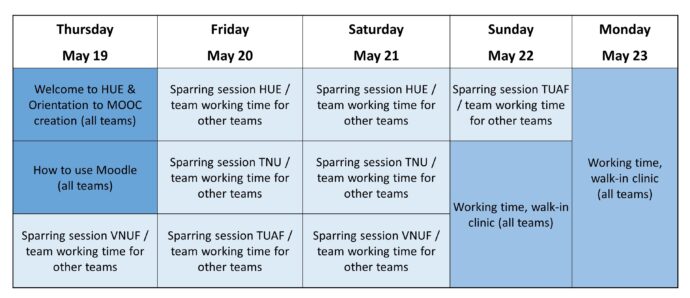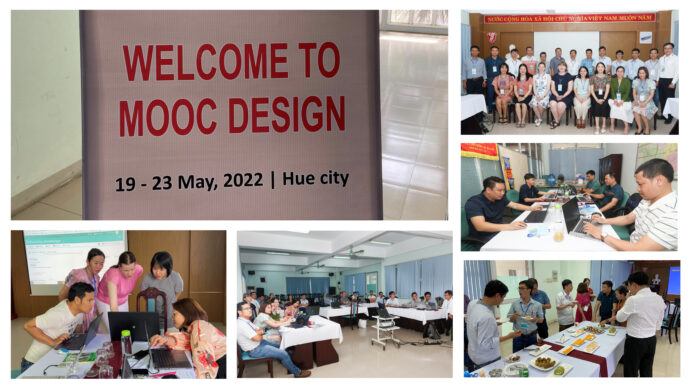In this article, we discuss creating MOOCs in the international collaboration between Vietnam and Finland in the context of an international educational development project. We introduce one of the project’s pedagogical solutions, namely the Training of Trainers on MOOC and how it is organized in practice. We describe the experiences of virtual collaboration in facilitating the creation of MOOCs and online courses, and we reflect the importance of face-to-face interaction during the process.
Context for international collaboration
The context of this article is an international educational development project called CLIDEV (Strengthening Climate Change Education for Sustainable Development in Vietnam)*. The main aim of the project is to enhance the forest and agriculture related higher education in Vietnam. The concrete actions include, for example, developing the current syllabuses content-wise and pedagogically, and creating totally new courses. In addition, the project aims to introduce digital teaching and learning tools and help partners to create MOOCs (massive open online courses). One of Laurea’s main tasks in the project is to facilitate and guide partners to create MOOCs. This is done via offering Training of Trainers on MOOC (ToT on MOOC) for the participants. In this article, we introduce how ToT on MOOC is organized in practice both in virtual collaboration and in face-to-face interaction.
ToT on MOOC: A training for facilitating the creation of MOOCs
Training of Trainers on MOOC (ToT on MOOC) ToT on MOOC is one of the pedagogical solutions in the CLIDEV project. It is a training of trainers on how to create a MOOC. The participants of the training are teachers and academics of four Vietnamese partner universities. The goal for the training is that after the training the participants are able to plan, design, and create a MOOC or online course in a pedagogically meaningful way.
ToT on MOOC in the CLIDEV project is organized in blended learning modality including both online and face-to-face activities (see Figure 1.). The training is divided into two phases: 1) online orientation and planning phase, and 2) implementation phase including intensive training week and online working.
Orientation and planning phase
ToT on MOOC started in February 2022 with an online orientation session. The session included information about the training and its learning outcomes as well as a short learning session about MOOCs and their key characteristics. In addition, four teams, one per each Vietnamese partner university, were formed to plan and create the MOOCs. The main aim of the orientation and planning phase was to facilitate the creation of a pedagogical manuscript (MOOC plan) for each MOOC to be created in the project.
After the orientation session, the four university teams started working with their MOOC plans. This was done collaboratively in a virtual learning environment Moodle. The online working progressed as a process via three thematic steps: 1) MOOCs idea, type, target group, and virtual learning environment, 2) Pedagogical and digipedagogical design, and 3) Pedagogical planning phases and cross-cutting themes. The result of this process was a MOOC plan ready to be implemented in the second phase of the training. In each step, the participants had versatile online learning materials at their disposal in Moodle which they studied and then created their own version of the MOOC plan as a group assignment. The four university teams received feedback from the facilitator of the training (the first author of this article) after each step, and they also received peer feedback from other university teams. This orientation and planning phase of the training lasted for three months, and the MOOC plans were ready to be implemented in mid-May 2022.
 Figure 1. ToT on MOOC training outline and schedule. The focus of this article is marked with green color (Pekkarinen 2022).
Figure 1. ToT on MOOC training outline and schedule. The focus of this article is marked with green color (Pekkarinen 2022).
Implementation phase
The second phase of the ToT on MOOC was the implementation phase, which aimed at concretely creating the MOOCs in the chosen virtual learning environment. The creation of MOOCs was based on the MOOC plans made in the previous phase. The implementation phase started with an intensive training week which took place in Vietnam between May 19 and 23, 2022 and was hosted by one of the partner universities, Hue University.
All together 19 participants from 4 partner universities took part in the intensive training week (see the structure of the intensive training week in Table 1.). The intensive training week included two learning sessions which all teams attended. These sessions dealt with how to create MOOCs and how to use Moodle learning environment both from the pedagogical and the technical point-of-view. In addition, there were two individual sparring sessions (á 2 hours, total 4 hours) for each university team for hands-on working together with the facilitator. There was also 12 hours of working time for each team to concretely and collaboratively create the MOOC in Moodle and learn and practice the use of Moodle.
 Table 1. Structure of the intensive training week (Laakkonen 2022).
Table 1. Structure of the intensive training week (Laakkonen 2022).
Intensive training week in Vietnam – developing digipedagogical understanding about MOOCs and virtual learning environments
Most of the participants in the ToT on MOOC and the intensive training week were unfamiliar with Moodle as virtual learning environment before the training. The online orientation and planning phase before the intensive training week was designed to enable the participants to familiarize themselves with Moodle in a student role before starting to create contents in Moodle in a teacher role. This is an important step because in MOOCs, the learning environment is entirely online. To be able to design a motivating learning environment for students requires understanding how students experience the virtual learning environment and what motivates students online. A well-designed learning environment also results in potentially higher retention rates among the participants of MOOCs. (e.g., Bawa 2016.) Enabling this experience for the participants seemed to be a good solution as the participants were very eager to learn to use Moodle and the different digital tools included.
During the intensive week, the participants were very motivated and eager to learn more about Moodle and MOOCs. Already after the first round of sparring sessions for the MOOC teams, the participants were able to use Moodle quite efficiently and test various tools. The teams wanted to learn how to use the basic Moodle tools, such as pages, links, videos, images, quizzes, and discussion forums, as well as more advanced tools, like interactive H5P tools that offer over 50 different opportunities for activating students. During the second round of sparring sessions, the participants already had quite advanced questions regarding the pedagogically meaningful use of the different digital tools, and they were able to consider the student point-of-view. The participants were also very eager to share what they had learned with each other. This peer teaching was a very efficient way of learning as peers are many times the best teachers of new things because they “speak the same language” that is, they are in the same situation (TeachThought Staff 2019). Working together as a team and sharing and discussing with each other and also with a facilitator enabled the participants to develop their Moodle skills rapidly. It was also the participants’ open-minded attitude and the courage to try out different technical options that resulted in a very positive outcome of the intensive training week. At the end, all the teams were able to start implementing their MOOC plans, that is, creating their MOOCs in Moodle.
 Figure 2. CLIDEV partners creating MOOCs during the intensive training week. Pictures are taken by Ho Ngoc Anh Tuan and Tarja Laakkonen and permission to use the pictures have been obtained.
Figure 2. CLIDEV partners creating MOOCs during the intensive training week. Pictures are taken by Ho Ngoc Anh Tuan and Tarja Laakkonen and permission to use the pictures have been obtained.
Discussion / conclusions
ToT on MOOC with the Vietnamese partners has been very interesting and eye-opening process during which we have met delightful successes but also some challenges, for example technical challenges like unstable internet connection during online sessions or information security, and access problems. In addition, cultural differences have influenced the process, for example, the working day is structured differently in Finland and in Vietnam. Nonetheless, all the challenges have been solved in good collaboration. The participants have been very motivated and open-minded, and they have had the courage to try out new ways of implementing teaching and learning. The face-to-face intensive training week was experienced as successful because the discussions and sparring sessions sped up the MOOC creation process immensely. The teams were also willing to share their own thoughts, outcomes and results with other teams which promoted the learning of all participants. The face-to-face training helped us to create a good and confidential collaboration which will benefit us in the future online training sessions.
After the intensive training week, ToT on MOOC in the CLIDEV project continues as online working (06-11/2022). All four university teams are working with their own MOOCs or online courses and creating content in the chosen virtual learning environment. Creating a MOOC is not a straightforward process but rather an iterative development process. There are online sparring sessions available for the university teams to facilitate and support their MOOC creation process during the fall 2022. The goal is that the MOOCs created in this training are ready to be piloted during the Fall 2022.
References
- Bawa, P. 2016. Retention in online courses: exploring issues and solutions – a literature review. SAGE Open. 6(1), 1-11. doi:10.1177/2158244015621777
- TeachThought Staff. 2019. Peer Teaching: A Definition. A Blog text written 12.11.2019. Available: https://www.teachthought.com/pedagogy/peer-teaching-definition/
*CLIDEV is a HEI-ICI project which has received 4-year funding from Finland’s Ministry for Foreign Affairs. The project is led by the University of Helsinki, and the other partners are Laurea and four universities from Vietnam (Hue University (HUE), Vietnam National University of Forestry (VNUF), Thai Nguyen University of Agriculture and Forestry (TUAF), and Tay Nguyen University (TNU)).